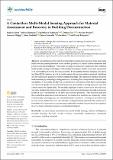| dc.contributor.author | Cabral, Sophia | |
| dc.contributor.author | Klimenka, Mikita | |
| dc.contributor.author | Bademosi, Fopefoluwa | |
| dc.contributor.author | Lau, Damon | |
| dc.contributor.author | Pender, Stefanie | |
| dc.contributor.author | Villaggi, Lorenzo | |
| dc.contributor.author | Stoddart, James | |
| dc.contributor.author | Donnelly, James | |
| dc.contributor.author | Storey, Peter | |
| dc.contributor.author | Benjamin, David | |
| dc.date.accessioned | 2025-02-03T16:08:42Z | |
| dc.date.available | 2025-02-03T16:08:42Z | |
| dc.date.issued | 2025-01-14 | |
| dc.identifier.uri | https://hdl.handle.net/1721.1/158153 | |
| dc.description.abstract | As material scarcity and environmental concerns grow, material reuse and waste reduction are gaining attention based on their potential to reduce carbon emissions and promote net-zero buildings. This study develops an innovative approach that combines multi-modal sensing technologies with machine learning to enable contactless assessment of in situ building materials for reuse potential. By integrating thermal imaging, red, green, and blue (RGB) cameras, as well as depth sensors, the system analyzes material conditions and reveals hidden geometries within existing buildings. This approach enhances material understanding by analyzing existing materials, including their compositions, histories, and assemblies. A case study on drywall deconstruction demonstrates that these technologies can effectively guide the deconstruction process, potentially reducing material costs and carbon emissions significantly. The findings highlight feasible scenarios for drywall reuse and offer insights into improving existing deconstruction techniques through automated feedback and visualization of cut lines and fastener positions. This research indicates that contactless assessment and automated deconstruction methods are technically viable, economically advantageous, and environmentally beneficial. Serving as an initial step toward novel methods to view and classify existing building materials, this study lays a foundation for future research, promoting sustainable construction practices that optimize material reuse and reduce negative environmental impact. | en_US |
| dc.publisher | Multidisciplinary Digital Publishing Institute | en_US |
| dc.relation.isversionof | http://dx.doi.org/10.3390/su17020585 | en_US |
| dc.rights | Creative Commons Attribution | en_US |
| dc.rights.uri | https://creativecommons.org/licenses/by/4.0/ | en_US |
| dc.source | Multidisciplinary Digital Publishing Institute | en_US |
| dc.title | A Contactless Multi-Modal Sensing Approach for Material Assessment and Recovery in Building Deconstruction | en_US |
| dc.type | Article | en_US |
| dc.identifier.citation | Cabral, S.; Klimenka, M.; Bademosi, F.; Lau, D.; Pender, S.; Villaggi, L.; Stoddart, J.; Donnelly, J.; Storey, P.; Benjamin, D. A Contactless Multi-Modal Sensing Approach for Material Assessment and Recovery in Building Deconstruction. Sustainability 2025, 17, 585. | en_US |
| dc.contributor.department | Massachusetts Institute of Technology. School of Architecture and Planning | en_US |
| dc.relation.journal | Sustainability | en_US |
| dc.identifier.mitlicense | PUBLISHER_CC | |
| dc.eprint.version | Final published version | en_US |
| dc.type.uri | http://purl.org/eprint/type/JournalArticle | en_US |
| eprint.status | http://purl.org/eprint/status/PeerReviewed | en_US |
| dc.date.updated | 2025-01-24T13:16:12Z | |
| dspace.date.submission | 2025-01-24T13:16:11Z | |
| mit.journal.volume | 17 | en_US |
| mit.journal.issue | 2 | en_US |
| mit.license | PUBLISHER_CC | |
| mit.metadata.status | Authority Work and Publication Information Needed | en_US |
